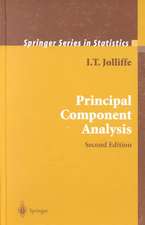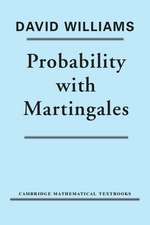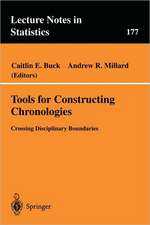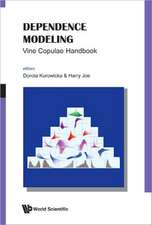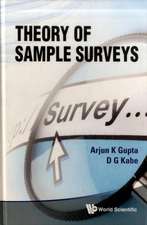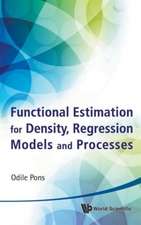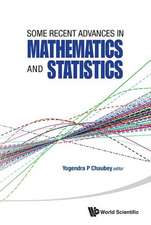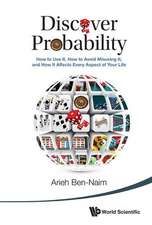A Modern Introduction to Probability and Statistics: Understanding Why and How: Springer Texts in Statistics
Autor F.M. Dekking, C. Kraaikamp, H.P. Lopuhaä, L.E. Meesteren Limba Engleză Hardback – 15 iun 2005
Introduction to the bootstrap is included – this is a modern method missing in many other books
| Toate formatele și edițiile | Preț | Express |
|---|---|---|
| Paperback (1) | 269.48 lei 3-5 săpt. | +36.13 lei 7-13 zile |
| SPRINGER LONDON – 19 oct 2010 | 269.48 lei 3-5 săpt. | +36.13 lei 7-13 zile |
| Hardback (1) | 253.64 lei 3-5 săpt. | +43.11 lei 7-13 zile |
| SPRINGER LONDON – 15 iun 2005 | 253.64 lei 3-5 săpt. | +43.11 lei 7-13 zile |
Din seria Springer Texts in Statistics
-
 Preț: 400.60 lei
Preț: 400.60 lei - 15%
 Preț: 559.21 lei
Preț: 559.21 lei - 18%
 Preț: 903.62 lei
Preț: 903.62 lei - 20%
 Preț: 764.93 lei
Preț: 764.93 lei - 20%
 Preț: 643.55 lei
Preț: 643.55 lei - 20%
 Preț: 717.71 lei
Preț: 717.71 lei - 13%
 Preț: 486.97 lei
Preț: 486.97 lei - 20%
 Preț: 633.82 lei
Preț: 633.82 lei - 20%
 Preț: 697.48 lei
Preț: 697.48 lei - 15%
 Preț: 676.86 lei
Preț: 676.86 lei - 15%
 Preț: 621.10 lei
Preț: 621.10 lei - 20%
 Preț: 700.51 lei
Preț: 700.51 lei - 18%
 Preț: 743.11 lei
Preț: 743.11 lei - 18%
 Preț: 695.29 lei
Preț: 695.29 lei - 17%
 Preț: 525.27 lei
Preț: 525.27 lei - 17%
 Preț: 428.39 lei
Preț: 428.39 lei - 19%
 Preț: 571.81 lei
Preț: 571.81 lei - 20%
 Preț: 567.30 lei
Preț: 567.30 lei -
 Preț: 359.54 lei
Preț: 359.54 lei -
 Preț: 477.28 lei
Preț: 477.28 lei - 20%
 Preț: 570.35 lei
Preț: 570.35 lei - 15%
 Preț: 650.86 lei
Preț: 650.86 lei - 19%
 Preț: 626.93 lei
Preț: 626.93 lei - 18%
 Preț: 948.29 lei
Preț: 948.29 lei -
 Preț: 500.46 lei
Preț: 500.46 lei - 18%
 Preț: 746.59 lei
Preț: 746.59 lei -
 Preț: 403.75 lei
Preț: 403.75 lei -
 Preț: 403.37 lei
Preț: 403.37 lei -
 Preț: 394.71 lei
Preț: 394.71 lei - 18%
 Preț: 946.69 lei
Preț: 946.69 lei - 15%
 Preț: 578.67 lei
Preț: 578.67 lei - 15%
 Preț: 702.54 lei
Preț: 702.54 lei -
 Preț: 407.01 lei
Preț: 407.01 lei - 18%
 Preț: 895.89 lei
Preț: 895.89 lei - 15%
 Preț: 600.80 lei
Preț: 600.80 lei - 23%
 Preț: 684.78 lei
Preț: 684.78 lei - 19%
 Preț: 543.08 lei
Preț: 543.08 lei - 15%
 Preț: 595.86 lei
Preț: 595.86 lei -
 Preț: 423.18 lei
Preț: 423.18 lei - 15%
 Preț: 656.10 lei
Preț: 656.10 lei - 15%
 Preț: 682.90 lei
Preț: 682.90 lei - 18%
 Preț: 814.43 lei
Preț: 814.43 lei -
 Preț: 402.76 lei
Preț: 402.76 lei -
 Preț: 408.54 lei
Preț: 408.54 lei
Preț: 253.64 lei
Nou
48.54€ • 51.90$ • 40.47£
Carte disponibilă
Livrare economică 27 martie-10 aprilie
Livrare express 13-19 martie pentru 53.10 lei
Specificații
ISBN-10: 1852338962
Pagini: 488
Ilustrații: XVI, 488 p. 120 illus. With online files/update.
Dimensiuni: 155 x 235 x 28 mm
Greutate: 0.86 kg
Ediția:2005
Editura: SPRINGER LONDON
Colecția Springer
Seria Springer Texts in Statistics
Locul publicării:London, United Kingdom
Public țintă
Lower undergraduateCuprins
Why probability and statistics?.- Outcomes, events, and probability.- Conditional probability and independence.- Discrete random variables.- Continuous random variables.- Simulation.- Expectation and variance.- Computations with random variables.- Joint distributions and independence.- Covariance and correlation.- More computations with more random variables.- The Poisson process.- The law of large numbers.- The central limit theorem.- Exploratory data analysis: graphical summaries.- Exploratory data analysis: numerical summaries.- Basic statistical models.- The bootstrap.- Unbiased estimators.- Efficiency and mean squared error.- Maximum likelihood.- The method of least squares.- Confidence intervals for the mean.- More on confidence intervals.- Testing hypotheses: essentials.- Testing hypotheses: elaboration.- The t-test.- Comparing two samples.
Recenzii
"[the material is] superbly motivated with interest-grabbing examples... exercises excellent and plentiful." Edward Williams, University of Michigan-Dearborn, USA
"... it is a notoriously hard task to introduce probability and statistics with a mix of intuition and mathematics to keep students motivated. Therefore, I very much welcome this book and recommend it as course material." Sara van de Geer, Leiden University, The Netherlands
"This textbook provides a well-written first course in probability and statistics...It is a book that has been written based on the long teaching experience of the authors and I would certainly recommend it for university coursework."Short Book Reviews of the International Statistical Institute, December 2005
"This book has numerous quick exercises to give direct feedback to the students. … A website at www.springeronline.com/978-1-85233-896-1 gives access to the data files used in the text … . This will be a key text for undergraduates in computer science, physics, mathematics, chemistry, biology and business studies who are studying a mathematical statistics course, and also for more intensive engineering statistics courses for undergraduates in all engineering subjects." (Rainer Beedgen, Zentralblatt MATH, Vol. 1079, 2006)
"The book is designed for a one-semester introductory course in probability and statistics basics for engineering students. … It can also be used by students in other more mathematically oriented majors such as applied mathematics with more emphasis on the mathematics and additional coverage in topics such as combinatorics, conditional expectation, and generating functions. … More elaborate exercises and real datasets are given at the end of each chapter." (Arthur B. Yeh, Technometrics, Vol. 49 (3), August, 2007)
Notă biografică
Michel Dekking, Cor Kraaikamp, Rik Lopuhaä and Ludolf Meester are professors in the Department of Applied Mathematics at TU Delft, The Netherlands. The material in this book has been successfully taught there for several years, and at the University of Leiden, The Netherlands, and Wesleyan University, USA, since 2003.
Textul de pe ultima copertă
Probability and Statistics are studied by most science students, usually as a second- or third-year course. Many current texts in the area are just cookbooks and, as a result, students do not know why they perform the methods they are taught, or why the methods work. The strength of this book is that it readdresses these shortcomings; by using examples, often from real-life and using real data, the authors can show how the fundamentals of probabilistic and statistical theories arise intuitively. It provides a tried and tested, self-contained course, that can also be used for self-study.
A Modern Introduction to Probability and Statistics has numerous quick exercises to give direct feedback to the students. In addition the book contains over 350 exercises, half of which have answers, of which half have full solutions. A website at www.springeronline.com/1-85233-896-2 gives access to the data files used in the text, and, for instructors, the remaining solutions. The only pre-requisite for the book is a first course in calculus; the text covers standard statistics and probability material, and develops beyond traditional parametric models to the Poisson process, and on to useful modern methods such as the bootstrap.
This will be a key text for undergraduates in Computer Science, Physics, Mathematics, Chemistry, Biology and Business Studies who are studying a mathematical statistics course, and also for more intensive engineering statistics courses for undergraduates in all engineering subjects.
Caracteristici
Uses real examples and real data sets that will be familiar to students
Features quick exercises to give direct feedback to the student, and over 350 exercises
Includes an introduction to the bootstrap, a modern method that is often missing in other books
Includes full solutions to half the exercises given in the book; solutions to the rest are provided on an accompanying website
Descriere
Probability and Statistics are studied by most science students, usually as a second- or third-year course. Many current texts in the area are just cookbooks and, as a result, students do not know why they perform the methods they are taught, or why the methods work. The strength of this book is that it readdresses these shortcomings; by using examples, often from real-life and using real data, the authors can show how the fundamentals of probabilistic and statistical theories arise intuitively. It provides a tried and tested, self-contained course, that can also be used for self-study.
A Modern Introduction to Probability and Statistics has numerous quick exercises to give direct feedback to the students. In addition the book contains over 350 exercises, half of which have answers, of which half have full solutions. A website at www.springeronline.com/1-85233-896-2 gives access to the data files used in the text, and, for instructors, the remaining solutions. The only pre-requisite for the book is a first course in calculus; the text covers standard statistics and probability material, and develops beyond traditional parametric models to the Poisson process, and on to useful modern methods such as the bootstrap.
This will be a key text for undergraduates in Computer Science, Physics, Mathematics, Chemistry, Biology and Business Studies who are studying a mathematical statistics course, and also for more intensive engineering statistics courses for undergraduates in all engineering subjects.



